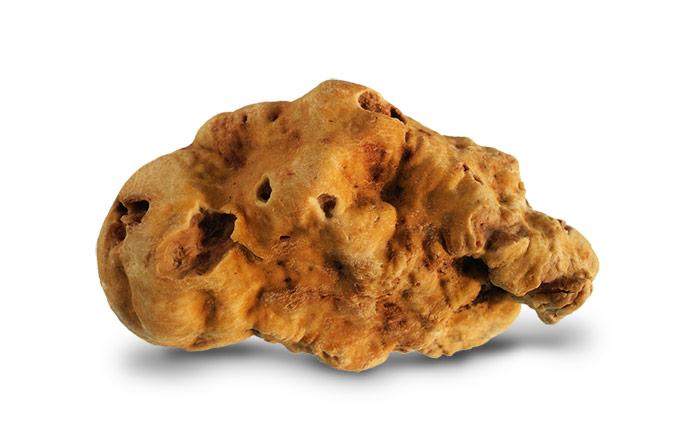Bianchetto or Marzuolo Truffle Tuber Borchii Vittadini

The Bianchetto truffle, also known by the name of Marzuolo and by its scientific name Tuber Borchii Vittadini. This species of truffle is widespread throughout the Italian peninsula and often confused with the white Alba truffle, to which it resembles in appearance: the name bianchetto evokes this very resemblance to its famous "big brother". This truffle is wide spread in the Italian cuisine, considering the fact that this truffle is spread over a big territory but still not as much as the prized Alba truffle. Yet, its intense aroma and low price make it a very appreciated condiment: if used wisely, the Bianchetto can give unmistakable and delicious flavors to both home and professional cooking.
Features
Appearance:
The white truffle shares many characteristics with the fine white truffle in its external appearance. It has a globular shape, with less iregularities, smooth and an ochre-white peridio, sometimes tending to darker tones between grey and brown. The most striking differences with the white truffle are found in the gleba, the Bianchetto has coarser veins. Unlike the fine white truffle the Bianchetto, when it ripens, darkens both on the outside and inside and taking on more brown and reddish tones. Its dimensions are usually smaller than those of the white truffle, and only in very rare cases they exceed ten centimeters.
Smell:
But the most striking difference between the Alba and the Bianchetto lies in the scent. The Bianchetto is characterized with a softer smell in the beginning which become more intense when ripened and taking on stronger and spicy tones that vaguely resemble the scent of garlic. Because of this characteristic, the Bianchetto truffle must be used in moderation in the kitchen, since its intense aroma tends to cover the taste of the dishes.
When to find it
The ripening period is another aspect that clearly distinguishes the bianchetto truffle from its white brother. The bianchetto matures between January and April, producing a large number of small specimens.
Where to find it
The Marzuolo truffle is extremely versatile and can grow in different types of soil, both along the coast and in flat, hilly and mountainous areas within a thousand meters above see level. It is widespread throughout Italy in broadleaf or conifer woods and is sometimes found even in particularly dry soils, an environment in which many other types of edible truffle do not grow. Outside the Italian borders, the bianchetto truffle is widespread in almost all of continental Europe and in southern England.
The symbiotic plants that are most commonly associated with the bianchetto truffle include:
- specimens of the oak family such as downy oak, Turkey oak and holm oak.
- Hornbeams and white hornbeams
- Specimens of the poplar family such as black and white poplar and tremulo poplar
- Beech
- Hazel
- Linden
- Examples of willow trees such as white willow
- Pine specimens such as black pine, domestic pine and Aleppo pine
- Other conifers such as larch, cedar and spruce
Prices
The Marzuolo truffle is much more widespread and therefore its availability it much bigger than the fine white truffle, this makes it considerably more affordable in terms of price: on average, we are talking about figures between 20 € and 30 € per hectogram. The fact that Bianchetto can be successfully grown in the special truffle-grounds also contributes to lower prices. Moresoever, since this truffle is generally less appreciated than the other prized varieties, the demand is less strong and has a lower probability to go beyond certain price thresholds.
